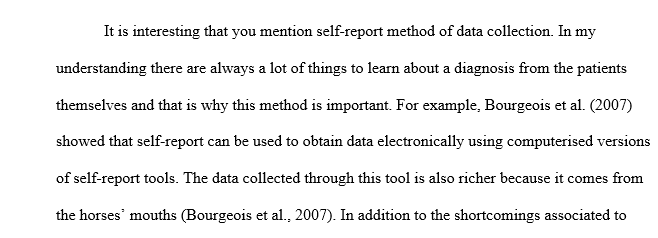Data collection methods used in research
Evidence-based discussion response 4
Post a thoughtful response to at least two (2) other colleagues’ initial postings. Responses to colleagues should be supportive and helpful (examples of an acceptable comment are: “This is interesting – in my practice, we treated or resolved (diagnosis or issue) with (x, y, z meds, theory, management principle) and according to the literature…” and add supportive reference. Avoid comments such as “I agree” or “good comment.”
Objectives
Describe various types, advantages, and disadvantages of data collection methods used in research
References:
Response posts: Minimum of one (1) total reference: one (1) from peer-reviewed or course materials reference per response.
Words Limits
Response posts: Minimum 100 words excluding references.
Discussion 1
For this weeks discussion I will be examining the Self-Report method of data collection and its shortcomings. When using a Self-Report method, the study participants relay their subjective feelings and experiences through interviews or surveys and questionnaires (LoBiondo-Wood & Haber, 2014, p.279). This method of data collection relies on participants to be honest and forthcoming, and there in lies one of the shortcomings.
In their evaluation of data collection methods for drug use Linas et al. (2016) note that while self report is considered a valid and reliable method of measurement for drug use it also faces the problems of recall and social desirability biases (p.1). LoBiondo-Wood and Haber (2014) further elaborate that people will give answers that are desirable to the researcher or that paints them in a favorable light (p.279). LoBiondo-Wood and Haber (2014) further note that the respondent burden poses a risk to research validity. Respondent burden occurs when the excessive length of the interview or survey that leads the respondent to “give up” and provide inaccurate responses to “escape” leading to skewed or incomplete data (p.279).
Self reporting is a common and useful tool in the clinical environment as it allows us to assess subjective measures of the patients experience such as pain, fear, and satisfaction with care. Self reporting is also frequently used in research to answer these same subjective questions. For example, if a researcher wanted to study the quality of life of adult amputees in the first 2 years following amputation they could utilize the self report method of data collection at one, three, or six-month intervals and possibly use this data to help future amputees by providing more assistance, education, or support during difficult time periods or stages following the loss of a limb.
References
Linas, B. S., Genz, A., Westergaard, R. P., Chang, L. W., Bollinger, R. C., Latkin, C., & Kirk, G. D. (2016). Ecological Momentary Assessment of Illicit Drug Use Compared to Biological and Self-Reported Methods. Journal of Medical Internet Research, 18(3), 13. doi:10.2196/mhealth.4470
LoBiondo-Wood, G., & Haber, J. (2014). Nursing research: Methods and critical appraisal for evidence-based practice (8th ed.). St. Louis, MO: Elsevier.
Discussion 2
Data collection is a big part of research. Researchers utilize information gathered to study phenomena or make changes and find solutions. Depending on the type and goal of the research, different data collection methods are used to get results. There are two types of data collection methods that is primary and secondary. Secondary data is usually already in circulation and can be found in books, journals or newspapers written by other people while primary data is usually data stemming from the person who carried out the research study (LoBiondo-Wood & Haber,2014). The purpose of the discussion board is to analyze one data collection method and discuss its pitfalls.
In my health care facility, questionnaires are used as a form of data collection to gauge patient’s experiences during their stay at the hospital. The questionnaire asks patients to rate their experience from excellent, moderate to poor. At the bottom of the form, patients are asked to include strengths, weaknesses and areas of improvement. Patients are not required to fill their names on the questionnaire and therefore are more likely to be open and honest in their responses. The questionnaires are given to the patients during admission and therefore are given plenty of time to answer the questions before discharge. There are various topics covered on the questionnaire including nutrition, environmental services, doctors and nurses’ availability, atmosphere on the floor. On the downside, questionnaires are impersonal and thereby a patient’s feelings and emotions are unknown. With questionnaires, there is a risk of getting untruthful answers (McCormack, Friedrich, Fahrenwald & Specker, 2014). Some patients may not be honest in their responses. Questionnaires may be interpreted differently by different individuals. For some patients, one question may have a different meaning than the other patient thereby resulting in inaccurate results. With questionnaires, there is no guarantee for compliance from the respondents and that may affect the results of the study (McCormack, Friedrich, Fahrenwald, & Specker, 2014).
Different methods of data collection have both advantages and disadvantages. As a researcher, it is important to check the credibility of the sources and gather as much information as possible to get accurate results. The process of data collection can be time consuming but it’s the end result that matters. Research studies are the basis of innovations in medicine and healthcare in general.
References
LoBiondo-Wood, G., & Haber, J. (2014). Nursing research: Methods and critical appraisal for evidence-based practice. 8th ed.St. Louis, MO: Elsevier.
McCormack, L., Friedrich, C., Fahrenwald, N., & Specker, B. (2014). Feasibility and acceptability of alternate methods of postnatal data collection. Maternal & Child Health Journal, 18(4), 852-857.
Solution preview for order on Data collection methods used in research
APA
390 words
